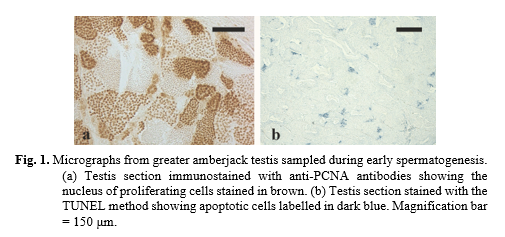SPERMATOGENESIS IN WILD AND CAPTIVE-REARED GREATER AMBERJACK Seriola dumerili (RISSO, 1810)
Introduction
Greater amberjack Seriola dumerili (Risso, 1810) is an excellent can didate for aquaculture thanks to its rapid growth, excellent flesh quality and worldwide market appreciation. As other captive-reared fishes exhibiting reproductive dysfunctions (Zohar and Mylonas, 2001) , greater amberjack males produced reduced sperm volume with a decreased sperm quality. The present work represents an overview of the results obtained in a comparative research study on the spermatogenesis of wild and captive-reared greater amberjack carried out in the framework of the EU FP7 project Diversify (www.diversifyfish.eu) (Zupa et al, 2017a, b).
Material and Methods
Twelve greater amber jack males caught from the wild and reared in captivity for three years in a sea cage in Salamina Island (Greece) and 14 males caught from the wild around Pelagie Islands (Sicily, Italy) , were sampled during three phases of the reproductive cycle: early spermatogenesis (late April-early May), advanced spermatogenesis (late May-early June) and spawning (late June-July). For each fish, biometric data (fork length, FL, in cm; body mass, BM, in kg ; testis mass, TM, in g) were registered and gonadosomatic index (GSI = 100 × TM/BM) calculated. T estis samples were chemically fixed and destined to basic histological analysis and to the identification of proliferating and apoptotic germ cells through the immunohistochemical detection of the proliferating cell nuclear antigen (PCNA) and the TUNEL method, respectively. Blood samples were centrifuged and plasma was collected and stored at -20°C for the analysis of 17β-estradiol (E2), testosterone (T), 11-ketotestosterone (11-KT) and 17,20β-dihydroxypren-4-en-3-one (17,20β -P) by ELISA assays.
Results and Discussion
Captive-reared fish showed lower GSI and smaller seminiferous lobules compared to wild fish in all the three phases of the reproductive cycle.
Anti-PCNA immunostaining was observed in the nuclei of spermatogonia and primary spermatocytes (Fig. 1a). All the captive-reared and most of the wild greater amberjack showed TUNEL-positive germ cells (Fig. 1b). Individuals reared in captivity showed a gradual decrease of germ cell proliferation throughout the three reproductive phases, which led to a precocious cessation of the spermatogenesis as well as a higher germ cell apoptosis in early spermatogenesis . In all three reproductive phases, captive-reared fish showed lower T, 11-KT and 17,20β-P plasma concentration s compared to wild fish ; however, captive-reared fish showed a many-fold higher E2 plasma levels during the early spermatogenesis.
The occurrence of a severe endocrine dysfunction was described in captive-reared greater amberjack males, including low T, 11-KT and 17,20β-P plasma levels during all the examined spermatogenesis phases. Abnormally high E2 plasma concentrations were associated to an increased germ cell apoptosis during early spermatogenesis . The observed reproductive dysfunction finally led to a lower sperm concentration and quality (Zupa et al., 2017a ). A s evere impairment of the reproductive function was observed also in females of the same broodstock and involved low steroid plasma concentrations and extensive atresia of late vitellogenic oocytes (Zupa et al., 2017b ). Preliminary data obtained within the H2020 project NewTechAqua indicate that hatchery-produced greater amberjack males reared in sea cages in Salamina (Greece) have similar GSI compared with wild fish sampled in the same period of the reproductive cycle (early June 2021). Although further analyses are required, the available data seem to suggest that the reproductive function might be less affected by captivity-induced stress in hatchery-produced greater amberjack than in wild-caught breeders.
Financial grant provided by the European Union´s Programmes FP7 (GA 603121, DIVERSIFY) and H2020 (GA 862658 , NewTechAqua).
References
Zohar, Y., Mylonas, C. C. 2001. Endocrine manipulations of spawning in cultured fish: from hormones to genes. Aquaculture, 197: 99–136.
Zupa, R., Fauvel , C., Mylonas, C. C., Pousis, C., Santamaria, N., Papadaki, Μ., Fakriadis, I., Cicirelli, V., Mangano, S., Passantino, L., Lacalandra, G. M., Corriero, A. 2017a . Rearing in captivity affects spermatogenesis and sperm quality in greater amberjack Seriola dumerili (Risso, 1810). Journal of Animal Science, 95: 4085-4100.
Zupa, R., Rodríguez, C., Mylonas, C. C., Rosenfeld, H., Fakriadis, I., Papadaki, M., Pérez, J. A., Pousis, C., Basilone, G., Corriero, A. 2017b . Comparative study of reproductive development in wild and captive-reared greater amberjack Seriola dumerili (Risso,1810). PLoS ONE 12(1): e0169645.
